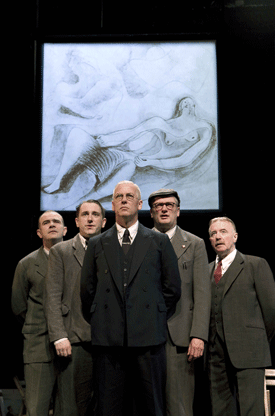One need not be interested in painting, mining or things British to enjoy “The Pitmen Painters,” an often funny and at times ferociously affecting new play currently on Broadway. The play was written by Lee Hall, whose screenplay and book for “Billy Elliot: The Musical” (still running) won the 2009 Tony Award.
Hall’s two plays have some aspects in common: both take place in the austere coal-mining district of northern Britain; both are based on true stories; and both concern manly men who, stretched by circumstances, take up a cultural pursuit uncommon to their class—ballet in “Billy Elliot,” oil painting in “Pitmen.”
The play is inspired by William Feaver’s book, Pitmen Painters, about a group of miners in Northumberland who, thanks to an art-appreciation class, began to paint. In the 1930s and 1940s, the work of the Ashington Group, as they called themselves, was exhibited internationally and acclaimed widely.
“The Pitmen Painters” ran for two years in London before the British ensemble was brought to the U.S. stage by way of the Manhattan Theatre Club. The cast is made up of three miners and a dental technician; their teacher, Robert Lyon (Ian Kelly), who is also an art historian; a model; and a wealthy art collector named Helen Sutherland (Phillippa Wilson).
The art class is both an ensemble of students and also of distinct individuals. One rule-bound miner is rigid in temperament; another is focused on domestic life, which can be seen in his paintings of his dogs, his living room table and the view out his window. The dental technician is a Communist sympathizer whose ideology breaks out in unbidden speeches about labor.
The character of Oliver Kilbourn (Christopher Connel) is the most highly developed. Not only is his painting noteworthy, but within the class he is the first to understand what art is, what role it can play in a society, what an artist is, and how art has spawned a business for collectors and dealers. The works shown throughout the play are select reproductions of paintings by the actual Ashington Group.
While the play has received criticism for being overly didactic, the classroom setting makes that allowable, as does the fact that the audience silently beholds how learning—about art and one’s own power to create it—changes the men in the class.
In the first classroom session, the teacher, Robert Lyon, discovers that his students do not have sufficient background—that is, they have not learned enough history nor have they visited museums or seen any real art—to learn from a standard art-appreciation course, which consists of discussing slides and comparing artists and genres period by period.
These students live in impoverished, rural communities and began work at a young age. Lyon, a member of the privileged, educated class, recognizes immediately that these men can learn best and quickest by making art themselves. So he asks them to paint something; their work will serve as the basis for conversation in class.
It is impossible to know what quality of work Lyon expected from his students. But when Oliver Kilbourn reluctantly shows his first painting of a miner, the audience all but gasps for the strength and emotion it contains. Art is no respecter of class. This man has raw talent and can put his deep passion on the canvas.
The student’s ignorance of the art world accounts for much of the play’s humor, such as when a model appears in the class before the teacher arrives and asks where she should remove her clothes.
A more disturbing scene takes place between Helen Sutherland and Oliver Kilbourn. Sutherland asks Kilbourn whether he would like her to sponsor him—to set him up in her studio so he can pursue his art. She has done this for another artist whom Kilbourn meets and finds disgruntled. Her proposition is delivered with erotic overtones, but Kilbourn decides not to accept it. “I’m a miner,” he tells her. Unlike Sutherland, he knows who he is, and how isolating and ruinous it would be for him to be thrust into her world, since his art is being mined from deep within his own.
One of the best scenes involves the men describing the art they encountered, for the first time, on a field trip to London. Their enthusiastic, fresh response is striking. Of Van Gogh’s painting of his bedroom, a miner says knowingly, “It’s not a rich man’s room.” While that might seem obvious, given the room’s simple, scant furnishings, the subtext is enlightened: the fact that it was not a rich man’s room didn’t stop the artist from painting it. Nor has it stopped viewers from deeming it a masterpiece.
That populist viewpoint is what “The Pitmen Painters” is all about.








